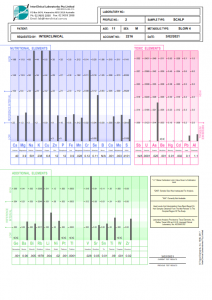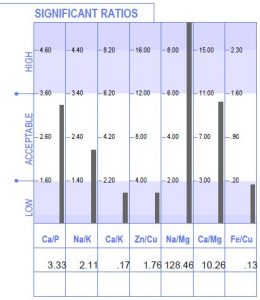Children, Mineral Imbalances & HTMA

Undetected mineral imbalances in children and teenagers cause health, educational, behavioural and social issues. Many of these are preventable and can be minimised by understanding and managing diet. Hair tissue mineral analysis is the definitive tool used by practitioners to identify nutritional imbalances and to create a treatment plan for ongoing management.
In a recent (2020) Polish study[i] it was found that an adequate intake of folates, vitamin D, vitamin E, magnesium, zinc and copper in the diet correlated with a higher level of cognitive development of 4-6-year-old children. The research emphasized the importance of vitamins and minerals for children to ensure their proper development.
The study concludes: Application of the proper nutrition and healthy lifestyle principles supports proper childhood development. All dietary components should be balanced, however some nutrients are of especial significance during the childhood developmental phase and therefore their optimal intake is essential for this developmental period.
As stated by Janine Castle: Following children through to teenage years with hair analysis is particularly important. The phases of childhood have different requirements, and gender also needs to be taken into consideration. An initial HTMA may reveal the baseline deficiencies and excesses requiring supplementation. However, a treatment plan for children must include scheduled annual repeat tests to monitor mineral levels and observe natural growth changes over a period of time. The full article by Janine Castle, Naturopath, BSc. Dip Appl Sci (Nat)[ii] is also in the current newsletter within snapshots or click here.
HTMA – 11 year old male Sydney, NSW
Background:
Medically diagnosed at the age of seven with autism – high functioning. The parents saw a dietician and clinical nutritionist of the period. Various conventional therapies including dietary and cognitive were trialled with minimal success. To date, there has been no improvement and worsening behavioural, social and learning issues. Additional symptoms include various environmental sensitivities, persistent headaches and dermatitis. His diet is limited compounded by his preference for sweet food, adversity to fruits and vegetables and beverage intake limited to water. Furthermore, the child will not take any nutritional supplementation. An Interclinical Laboratories Hair Tissue Mineral Analysis (HTMA) was conducted. (Read Report)

Summary of HTMA Findings (View Report)
Nutritional Elements
High sodium: might be excretion due to high sodium diet, could indicate low HCl production, can also indicate acute elevated adrenal function
High potassium: May Indicate elevated adrenal function.
High copper: frontal headaches, mood disorders and allergies
Low Zinc: – Slows growth and development Low zinc can alter the taste buds, allergies might influences the preferred foods (therefore Fussy eater)
Low phosphorus: showing low absorption of proteins and low utilisation of the sodium
Low iron: can also contribute to anxiety and tiredness.
Bloods sugar imbalances: low manganese, high chromium (and high vanadium)
Low sulphur: showing low functioning sulphur pathways.
Relatively low absorption is shown across the graphs consistent with nutrient insufficiencies.
Toxic elements:
Arsenic: May cause skin issues, anorexia, drowsiness, confusion, headaches, weakness and nervousness to mention a few symptoms
Lead: May cause anger and hostile feelings, can have a profound affect on growth and development
Aluminium: May cause dyslexia, neurological disease
Additional Elements:
High vanadium: may mimic insulin
High rubidium: follows potassium

Ratios Summarised
Low Na/K ratio: may show emotional symptoms such as anxiety, withdrawal
Low Ca/K ratio: Elevated thyroid function may cause nervousness, anxiety, irritability, sweating, tachycardia, palpitations, arrhythmia
High Zn/Cu ratio: Allergies
High Na/Mg ratio: high body stress indicates elevated adrenal function
Low Fe/Cu ratio: may cause anaemia
Comments from Profile 2 Interpretive report
Allergies
Since the patient’s zinc level is low in relation to copper, and the tissue copper level is elevated, a low serum histamine may be present. This may result in histamine depletion if chronic. The mineral copper is a constituent of the enzyme histaminase and the protein ceruloplasm, both of which have the ability to destroy histamine. Zinc is required for the storage of histamine. Low histamine levels have been found in the serum of patients who suffer from allergies to foods and inhalants.
Anaemia
Copper in excess amounts can contribute to iron deficiency anaemia, by interfering with iron absorption and decreasing the metabolic activity of iron. A low iron to copper ratio indicates a trend toward anaemia.
Dermatitis
Copper is known to antagonize the metabolic activity of zinc as well as decrease its absorption. This may be a contributing factor to copper-induced dermatitis. Copper toxicity often produces skin rashes that are characterized by red itchy areas occurring on the face, neck, and lower back, on the thighs, and behind the knees.
Headaches
Elevated copper has been implicated in producing headaches, usually occurring in the frontal region.
Arsenic
Hair tissue mineral studies have shown that arsenic antagonizes the absorption and retention of some nutrient minerals, such as iron and selenium. This antagonism may contribute to lower levels of these minerals in the body.
Food Allergies
Excess intake of high copper foods has been associated with several reactions, both physical and emotional. Physical reactions may include frontal headaches, skin rashes, joint stiffness, constipation, insomnia causing morning fatigue, bloating, water retention and cold sensitivity. Emotional reactions may include depression, crying spells, fearfulness, anxiety, irritability, anger, aggressive behaviour and withdrawn.
Note the elevated level of copper to zinc in his report. Copper levels and copper mediated neurotoxicity may be related to the formation of copper dopamine complex. This status may be associated with learning disabilities and general behavioural issues. Zinc metabolism can be important in the development of neurological dysfunctions.[iii]
Metabolic type
Slow Metaboliser Type 4 is para-sympathetic dominant with Sub Type 4. Most healthy children are fast metabolisers with sympathetic dominance, which is necessary for growth and development. Type 4 indicates that their body has been in a stressed state (Type 3) for a period. This chronic stress may have been due to emotional, physical, environmental factors or possibly due to medication or toxic metals. An acute reaction due to an emotional or physical event has triggered a change which has resulted in elevated thyroid and adrenal function (Type 4).
Trends take from the Profile 2 report
Allergies (high tendency)
Anaemia (relatively high tendency)
Dermatitis (low tendency)
Headaches (low tendency)
Periodontal problems (low tendency)
Dietary and Supplemental Recommendations
The Profile 2 Interpretive report provides detailed suggestions of foods that should be restricted and those that should be increased. The recommendation of more frequent meals, with high protein food has been adopted – including foods such as Turkey and Chicken (even for breakfast).
The relative deficiency of zinc (as discussed in the report) can cause food to be flavourless, therefore increasing the zinc is seen as an important first step. The boy’s minimal diet and refusal to take supplements has meant that creative methods had to be found. The zinc supplement with methionine (also recommended) has been added to the nightly homemade (dairy-free) banana ice-cream, and vitamin C added to the strawberry ice-cream. Bananas have been recommended to increase magnesium along with corn.
The practitioner further engaged the child by showing him his graphs, and discussing what they were trying to achieve. He was excited about being able to monitor his own changes.
Conclusion
Hair Tissue Mineral Analysis has proven to be an invaluable assessment tool for this young 11-year-old boy and his troubled family. The HTMA report identified the many significant nutritional imbalances and provided the practitioner the clinical data required to map a pathway to improved health. As the nutritional therapy is gentle a re-test will be conducted in about 4 months’ time.
For more information from InterClinical Laboratories about HTMA testing, visit here.
[i] Zysk, B., Stefanska, E., Ostrowska, L. (2020). Effect of dietary components and nutritional status on the development of pre-school children. Annals of the National Institute of Hygiene, 71(4). doi:10.32394/rpzh.2020.0133
[ii] InterClinical Laboratories
[iii] Viktorinova, A., Ursinyova, M., Trebaticka, J., Uhnakova, I., Durackova, Z., & Masanova, V. (2015). Changed Plasma Levels of Zinc and
Copper to Zinc Ratio and Their Possible Associations with Parent- and Teacher-Rated Symptoms in Children with Attention-Deficit Hyperactivity Disorder. Biological Trace Element Research, 169(1), 1–7. doi:10.1007/s12011-015-0395-3

No Comments
Sorry, the comment form is closed at this time.